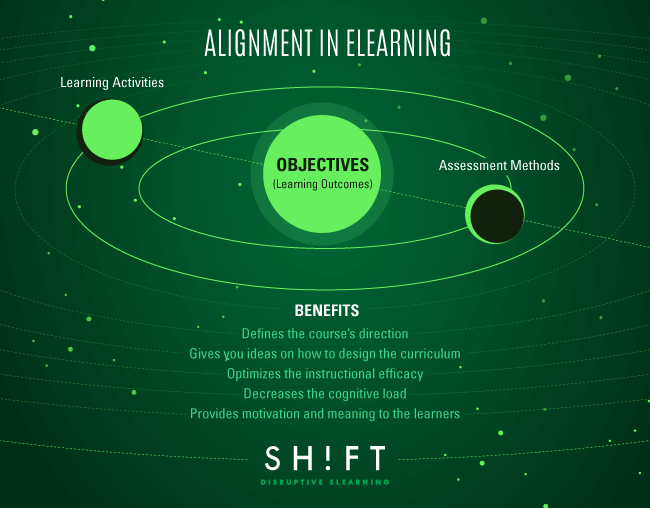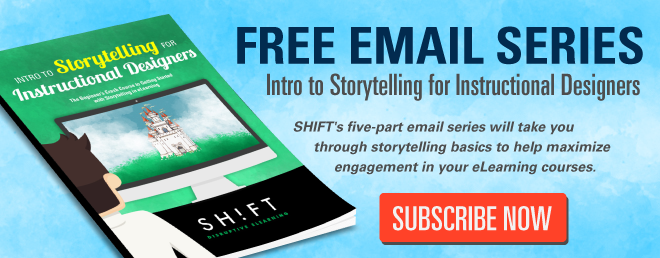“The instructional decisions we make will increase the probability that our students will learn”—Anonymous.
How do you dress? For the occasion, of course. How do you choose your accessories? So they match the dress. You take care to turn out in a well-coordinated outfit. Then why shouldn't the eLearning courses you create show such harmony? The watchword here is alignment. The most effective eLearning courses are perfectly aligned, but most often this objective gets the miss when the course is being planned. At other times, eLearning designers are clueless about the concept, so they naturally do not realize their courses are all over the place but not going where they are supposed to head to.
What is Alignment in eLearning Courses?
Alignment or integrated course design means creating courses where the objectives or learning outcomes, learning activities, and assessment tasks are consistent or are closely associated. In fact, the closer the association, the more instructionally effective is the course.

Here's how the alignment comes about:
It all starts with the objectives or the learning outcomes.
You draft the objectives after taking into consideration what your target audience is supposed to learn or be able to do after taking the course. This means that you have to create instructional content that teaches what your learners want to learn. You have to also formulate learning activities that will make the learners apply their newly-acquired knowledge to answer questions or solve problems that they are likely to face in real life. You should design the assessment so that it maps with the objectives and lets you figure out if the learners have imbibed what they had set out to learn.
--> Check this 2-page guide
Here's what an aligned course looks like:
Let's say a new software system has been put in place in an office, and your target audience comprises employees who have to learn to operate this system to perform certain tasks as part of their job responsibilities. So the learning outcomes are clear.
Now you have to design instructional content and learning activities that "align" with the objectives. So don't plunk down a list of the features and be done with that. Nor will a step-list of actions fulfill the learning objectives. You have to take your learners on a (virtual) tour of the software system where they can "look around" and get a "feel" of the environment. They should be able to see tabs and buttons being clicked, elements being selected, and tasks being performed using the in-built options and features of the software. The learners should also be able to see the results of the actions taking place. Think show-and-tell mode! You can also design show-tell-and-do learning activities to make the learners interact with the software interface and learn hands-on.
The assessment activities should test the learners on the ability to apply their knowledge to find their way around the software and interact with it to carry out specific tasks. Just asking them to list the features of the software system or their benefits will not fulfill the learning objectives because that's not what they will do when they go back to their workplaces.
Bringing about alignment in an eLearning course is all about planning. The learner experience is critical here. You should plan your course so that the learning mirrors reality and the learner can build upon his knowledge meaningfully and sequentially. This is constructive alignment.
What Are the Benefits of Creating Aligned eLearning Courses?
Why should you go into all the trouble to map objectives, the instructional content, and assessment? How will alignment help you or your learners? Here's how:
- Alignment gives direction to the course. The key components of every eLearning course are the learning objectives, the content, the teaching and learning activities, and the assessment. The instructional content, the activities, and the assessment follow from the objectives, and all the elements map to one another. When you keep these rules of thumb in mind, there is no way your course is going to end up all over the place.
- Planning for alignment gives you ideas on how to design the curriculum. The instructional strategy you formulate depends on the objectives you had created. The type of assessment activities to choose—case studies or project work that the learner will complete back at their desks—will be determined by how effectively each maps with the objectives. When you aim for "alignment," the cues for an effective design strategy become evident.
- Alignment optimizes the instructional efficacy of the course. When your instructional content, and learning activities align with the objectives, students learn and get tested on what they had signed up for. When you align the content with the objectives, you have a foolproof parameter to evaluate the efficacy of your learning strategy and tweak or redesign as needed.
- Alignment decreases the cognitive load of the course. Say for instance, learners are expected to learn to be able to compare and contrast the pros and cons of similar products of different brands after taking the course. But what if the content does not align with the objectives? If the instructional content had only harped on the features of the products, learners will obviously keep wondering where the course is leading them to or fumble around for answers when presented with assessment activities that make them "compare and contrast." This increases the cognitive load of the course.
- Alignment provides motivation and meaning to the learners. When learners see that the instructional content, learning activities, and the assessment match the tasks they are expected to perform after completing the course, they find it meaningful and thus feel more motivated (read: less cynical) to carry on.
The One Golden Rule of Aligning eLearning Courses
What is the yardstick? How do you know that the instructional content aligns with the objectives? Can you find out if the assessment maps to the learning outcomes? And how do you draft the objectives in the first place, so they align with the expectations of the learners?
Let Bloom's Revised Taxonomy guide you. As eLearning designers, we are all familiar with Bloom's Taxonomy that lists the various types of cognitive tasks (the levels of learning) learners are expected to perform while taking the course. Bloom's Revised Taxonomy takes it a step farther and introduces types of knowledge that can be mapped to the levels of learning. So you now have a dashboard of sorts, where you can create a holistic view of the learning objectives, the instructional content, and the assessment. You know immediately if there is any mismatch!
As a conscientious eLearning designer, you owe your learners an aligned course. Show empathy!
References:
Maximizing Learning Through Course Alignment and Experience with Different Types of Knowledge. Phyllis Blumberg. 2009



